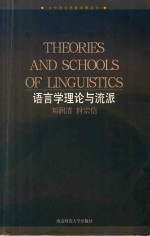

语言学理论与流派PDF电子书下载
- 电子书积分:15 积分如何计算积分?
- 作 者:刘润清,封宗信著
- 出 版 社:南京:南京师范大学出版社
- 出版年份:2004
- ISBN:781047684X
- 页数:455 页
Chapter 1 Introduction:Language and Linguistics 1
1.1 What Is Linguistics? 3
1.2 Is Linguistics a Science? 5
1.3 Branches of Linguistics 7
1.4 Linguistic Theories:Past and Present 9
Chapter 2 A Brief History of Linguistics:An Overview 16
2.0 Introduction 16
2.1 Linguistics in Ancient Times 19
2.1.1 Indian Linguistics 19
2.1.2 Chinese Linguistics 24
2.1.3 Greek Linguistics 27
2.1.4 Roman Linguistics 31
2.2 Linguistics in the Middle Ages 35
2.2.1 Aelfric's Latin Grammar and Colloquium 36
2.2.2 Alexander of Villedieu's Doctrinale 36
2.2.3 The First Grammatical Treatise 37
2.2.4 Scholasticism and Speculative Grammars 37
2.2.5 Logicalisation of Grammar 42
2.2.6 Petrus Hispanus and the Summulae logicales 43
2.3 Linguistics in the Renaissance 46
2.3.1 Hebrew and Arabic 47
2.3.2 European Languages 49
2.3.3 The Port-Royal Grammarians 52
2.3.4 Empiricism and the Reworking of English Grammars 55
2.4 Linguistics in the 18th Century 59
2.4.1 The Discovery of Sanskrit 59
2.4.2 Philosophical and Linguistic Inquiries 61
2.5 Conclusion 67
Chapter 3 The 19th-century Historical and Comparative Linguistics 69
3.0 Introduction 69
3.1 Early Efforts in Historical Linguistics 71
3.2 Rask,Grimm,and Verner 74
3.3 Humboldt and Schleicher 78
3.4 Neogrammarians 86
3.5 Sanskrit and Historical Linguistics 91
3.6 Conclusion 92
Chapter 4 The Beginning of Modern Linguistics 94
4.0 Introduction 94
4.1 Saussure the Man 95
4.2 Historical Background 98
4.2.1 Linguistics 98
4.2.2 Sociology 101
4.2.3 Psychology 105
4.3 The Making of the Course 108
4.4 Saussure and Comparative Linguistics 110
4.5 Saussure's Theory of Language 114
4.5.1 The Arbitrary Nature of the Sign 115
4.5.2 The Linear Nature of the Signifier 118
4.5.3 The Immutable Nature of the Signifier 120
4.5.4 The Nature of Linguistic Units 121
4.5.5 Langue and Parole 125
4.5.6 Synchrony and Diachrony 129
4.6 Saussure's Legacy:Semiology 132
4.7 Conclusion 136
Chapter 5 American Descriptive and Structuralist Linguistics 140
5.0 Introduction 140
5.1 The Founding Stage 142
5.1.1 Franz Boas 142
5.1.2 Edward Satpir 146
5.1.3 The Sapir-Whorf Hypothesis 158
5.2 The Bloomfieldian Age 166
5.2.1 Bloomfield the Man 166
5.2.2 Bloomfield and Behaviourism 168
5.2.3 Bloomfield and his Language 172
5.2.4 Structuralism and Language Teaching 177
5.3 The Post-Bloomfieldian Period 179
5.3.1 Zellig Harris 180
5.3.2 Charles Hockett 190
5.3.3 Kenneth Pike 194
5.4 A Comparison between Traditional and Structural Grammars 200
5.5 Conclusion 201
Chapter 6 Chomsky and Transformational-Generative Grammar 203
6.0 Introduction 203
6.1 Chomsky the Man 204
6.2 Chomsky's Philosophy of Language 205
6.2.1 Background 205
6.2.2 What Is Language? 207
6.2.3 The Innateness Hypothesis 208
6.2.4 Universal Grammar and Particular Grammar 212
6.2.5 What Is a Generative Grammar? 213
6.3 The Classical Theory 214
6.4 The Standard Theory 223
6.5 The Extended Standard Theory 229
6.6 Government and Binding Theory 251
6.7 The Minimalist Program and Inquiries 261
6.8 A Comparison between TG Grammar and Structural Grammar 265
6.9 Conclusion 266
Chapter 7 Early Functionalist Linguistics Theories 269
7.0 Introduction 269
7.1 The Prague School 270
7.1.1 Historical Background 270
7.1.2 Theories of Language 272
7.1.3 Phonology and Phonological Opposition 279
7.1.4 Distinctive Features 283
7.1.5 Functional Sentence Perspective(FSP) 286
7.2 The Copenhagen School— 293
7.3 The London School 297
7.3.1 B.Malinowski 299
7.3.2 J.R.Firth 302
7.4 Conclusion 310
Chapter 8 Halliday and Systemic-Functional Grammar 312
8.0 Introduction 312
8.1 Halliday the Man 312
8.2 Halliday's Philosophy of Language 314
8.3 Systemic Grammar 316
8.3.1 Entry Conditions 320
8.3.2 Scale of Delicacy 321
8.3.3 Meaning Potential and Realisation 323
8.4 Functional Grammar 324
8.4.1 The Ideational Function 326
8.4.2 The Interpersonal Function 333
8.4.3 The Textual Function 336
8.5 Halliday and Sociolinguistics 339
8.5.1 Language and Social Man 339
8.5.2 Field 342
8.5.3 Tenor 343
8.5.4 Mode 344
8.5.5 Register and Genre 345
8.6 Theoretical Issues 347
8.7 Conclusion 352
Chapter 9 Linguistic Theories in the Latter Half of the 20th Century 355
9.0 Introduction 355
9.1 Stratificational Grammar 355
9.2 Case Grammar 360
9.3 Generative Semantics 367
9.4 Relational Grammar 373
9.5 Montague Grammar 378
9.6 Conclusion 383
Chapter 10 Modern Chinese Linguistics 385
10.0 Introduction 385
10.1 The Beginning Stage 387
10.1.1 The Pioneer:Ma Jianzhong 387
10.1.2 Classical Chinese Grammars 389
10.1.3 Vernacular Chinese Grammars 392
10.2 The Stage of Innovation 394
10.2.1 Pioneers:Wang Li,Chen Wangdao and Fang Guangtao 395
10.2.2 Wang Li:Modern Chinese Grammar 399
10.2.3 Lü Shuxiang:Aspects of Chinese Grammar 401
10.2.4 Gao Mingkai and his On Chinese Grammar 403
10.2.5 Structuralist Chinese Grammars 407
10.3 The Stage of Prosperity 410
10.3.1 Grammar and Language Learning 411
10.3.2 School Grammars 412
10.4 The Stage of Full Development 414
10.4.1 LüShuxiang:Problems of Grammatical Analysis in Chinese 415
10.4.2 Zhu Dexi and Modern Chinese Grammar 418
10.4.3 The Three-Level Analysis 419
10.4.4 The Linguistic Association of China 421
10.4.5 Further Systematic Studies 422
10.5 Chinese Linguistics Overseas 424
10.5.1 Structuralist Chinese Linguistics 425
10.5.2 Transformational-Generative Chinese Linguistics 428
10.5.3 Functionalist Chinese Linguistics 429
10.5.4 The International Association of Chinese Linguistics 431
10.6 Conclusion 432
Bibliography 437
Index 445
后记 455
- 《SQL与关系数据库理论》(美)戴特(C.J.Date) 2019
- 《联吡啶基钌光敏染料的结构与性能的理论研究》李明霞 2019
- 《情报学 服务国家安全与发展的现代情报理论》赵冰峰著 2018
- 《英汉翻译理论的多维阐释及应用剖析》常瑞娟著 2019
- 《新课标背景下英语教学理论与教学活动研究》应丽君 2018
- 《党员干部理论学习培训教材 理论热点问题党员干部学习辅导》(中国)胡磊 2018
- 《虚拟流域环境理论技术研究与应用》冶运涛蒋云钟梁犁丽曹引等编著 2019
- 《当代翻译美学的理论诠释与应用解读》宁建庚著 2019
- 《程序逻辑及C语言编程》卢卫中,杨丽芳主编 2019
- 《环境影响评价公众参与理论与实践研究》樊春燕主编 2019
- 《中风偏瘫 脑萎缩 痴呆 最新治疗原则与方法》孙作东著 2004
- 《水面舰艇编队作战运筹分析》谭安胜著 2009
- 《王蒙文集 新版 35 评点《红楼梦》 上》王蒙著 2020
- 《TED说话的力量 世界优秀演讲者的口才秘诀》(坦桑)阿卡什·P.卡里亚著 2019
- 《燕堂夜话》蒋忠和著 2019
- 《经久》静水边著 2019
- 《魔法销售台词》(美)埃尔默·惠勒著 2019
- 《微表情密码》(波)卡西亚·韦佐夫斯基,(波)帕特里克·韦佐夫斯基著 2019
- 《看书琐记与作文秘诀》鲁迅著 2019
- 《酒国》莫言著 2019
- 《大学计算机实验指导及习题解答》曹成志,宋长龙 2019
- 《大学生心理健康与人生发展》王琳责任编辑;(中国)肖宇 2019
- 《大学英语四级考试全真试题 标准模拟 四级》汪开虎主编 2012
- 《大学英语教学的跨文化交际视角研究与创新发展》许丽云,刘枫,尚利明著 2020
- 《复旦大学新闻学院教授学术丛书 新闻实务随想录》刘海贵 2019
- 《大学英语综合教程 1》王佃春,骆敏主编 2015
- 《大学物理简明教程 下 第2版》施卫主编 2020
- 《大学化学实验》李爱勤,侯学会主编 2016
- 《天水师范学院60周年校庆文库 新工科视域下的工程基础与应用研究》《天水师范学院60周年校庆文库》编委会编 2019
- 《中国综合性大学法语学科表征研究》田园著 2019
